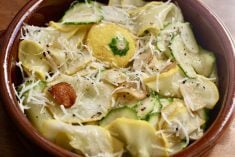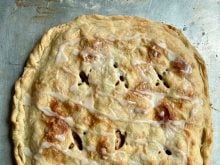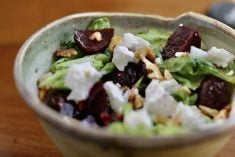Every country’s cuisine uses some form of the onion. It adds flavour to many recipes and has health benefits.
I remember as a child that my mother would make an onion plaster for my chest when I had a bad cold. Roman emperor Nero used onion as a cure for colds. In the past, it was used during epidemics to ward off cholera.
Onions contain natural sugar, vitamins A, B6, C and E and minerals such as sodium, potassium and iron and have dietary fibre. They are also a good source of folic acid, which is not stored in the body.
Read Also

Fuel rebate rule change will affect taxes and AgriStability
The federal government recently announced updates to the fuel rebates that farmers have been receiving since 2019-20.
They must be consumed daily and are important in brain health and cell growth.
When purchasing onions, they should be clean and hard and have dry, smooth skins.
Avoid onions that show any growth in the stem end. Store at room temperature, away from light, and keep well ventilated. I store mine in a basket on my countertop.
The more pungent onions, like yellow onions, keep longer than the sweeter onions.
Always store onions away from potatoes because the potatoes will absorb their moisture and ethylene gas and spoil more easily.
Storing cooked onions in a metal bowl will cause them to discolour. Freezing chopped onions will cause them to lose much of their flavour.
When peeling off the outer layers of the onion, use them to add a rich colour to soups and stews.
If chopping onions brings tears to your eyes, chill them for half an hour before cutting.
How to caramelize onions
Cut, peel and trim ends of a large onion and slice in half from stem to root. Slice thinly into half moon pieces. Using equal parts olive oil and butter, gently heat in a cast iron or heavy bottomed pan. Add onions.
Over medium heat, saute until onions are translucent. Reduce heat to medium-low and continue to cook, stirring until lightly browned.
This may take 30 to 45 minutes depending upon how large your batch is.
What to use: sweet, sharp, mild, crispy?
- Sweet : Walla Walla, Vidalia, Bermuda Use for frying, onion rings, deep fried onion rose
- Red: mild and sweet – use raw in a salad or sandwich, pickled
- White: crunchy and sharp – salsa, chutney, stir fry
- Yellow: all purpose – use with roasts, sauce, soup
- Shallot: milder and subtle for vinaigrette, eggs, garnish
- Green: mild and crunchy – usually used raw but can be roasted
- Chives: mild – use as garnish, vinaigrette or raw
- Pearl: sweet and mild – for roast, pickle, in stews
- Leeks: mild – usually cooked, ham and leek bake
Onion and poppyseed crackers
- 1 medium onion
- 1 large egg
- 1/3 c. vegetable oil 80 mL
- 2 tsp. salt 10 mL
- 2 c. flour 500 mL
- 1 tsp. baking powder 5 mL
- 2 tbsp. poppyseeds 30 mL
- 1 tbsp. granulated sugar 15 mL
- 1/4 tsp. freshly ground black pepper 2 mL
In the bowl of a food processor fitted with the blade attachment, puree the onion. One medium onion will yield approximately one cup puree. Measure one cup puree and liquid from the onion and return to the food processor. Add the egg, oil and salt and blend until well incorporated.
Lightly knead the dough, flouring as needed, for two minutes. Wrap tightly in plastic wrap and rest in the refrigerator for one hour.
Preheat oven to 350 F (175 C).
This is a soft dough so it’s best to roll it between two sheets of well-floured parchment paper. Roll as thinly as possible. In fact, it is best if rolled as thinly as a strudel dough. Cut into desired shapes. Bake until evenly golden. The time required will depend upon thickness, from five to 15 minutes. If they are thicker, the crackers will puff up like pitas.
Cool thoroughly before storing in airtight container. Makes about four dozen. – Adapted from Menus from an Orchard Table by Heidi Noble.
Pissaladiere
This traditional dish from Provence, France, is like a pizza and is typically served at room temperature.
- 2 tbsp. olive oil 30 mL
- 2 tbsp. butter 30 mL
- 6 large onions
- 1 tbsp. fresh thyme leaves 15 mL
- 2 cloves garlic, thinly sliced
- 1/2 tsp. sea salt 3 mL
- 1 tin anchovy fillets, packed in oil
- 1 c. kalamata olives, pitted 250 mL
- 2 tbsp. capers 30 mL
- 1 pkg. puff pastry
Caramelize onions, then add garlic and cook until garlic is slightly browned.
Roll out cold puff pastry into two eight- by 12-inch (20 cm x 30 cm) rectangles. Turn up the edges about 1/2 inch (3 cm) and crimp to make a border. Place on parchment lined baking pan and refrigerate until onions are ready.
Preheat oven to 400 F (205 C). Spread caramelized onions over the pastry. Rinse anchovies and capers in cold water and pat dry with a paper towel. Place anchovies over the onions in a crosshatch pattern, then place an olive in each diamond and sprinkle with capers.
Bake until edges of pastry are browned. Remove from oven and garnish with more fresh thyme leaves and serve. Serves six to eight people. Adapted from Menus from an Orchard Table by Heidi Noble.
French onion soup
- 2 tbsp. butter 30 mL
- 2 tbsp. vegetable oil 30 mL
- 4 large onions, peeled and thinly sliced
- 1/2 c. brandy or fortified wine such as Madeira 125 mL
- 4 c. chicken broth 1 L
- 2 sprigs fresh thyme leaves
- sea salt and freshly ground pepper, to taste
- 4 slices hearty bread or large croutons
- 2 c. shredded Swiss, Gruyere or Emmental cheese 500 mL
Caramelize onions until they are a deep golden colour. Add brandy. Turn up the heat and cook for a few minutes, stirring constantly, until the additional liquid has evaporated.
Add the chicken broth and bring to a simmer. Add the thyme leaves, season with salt and pepper and continue cooking for 15 minutes.
To serve, preheat the broiler in your oven. Toast the bread slices to add flavour and help absorb the soup.
Cut rounds out of the toast, large enough to fit your soup bowls.
Ladle the soup into four ovenproof serving bowls. Top each with a slice or two of toasted bread rounds, enough to cover the top of the soup. Cover the bread with an even mound of shredded cheese. Broil until the cheese has melted and browned. – Adapted from chef Michael Smith.
















